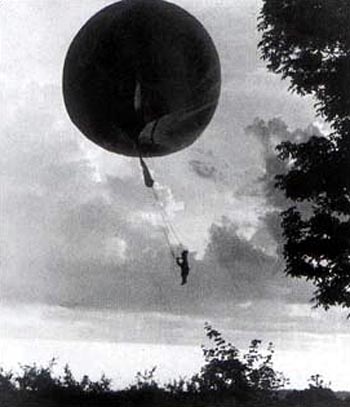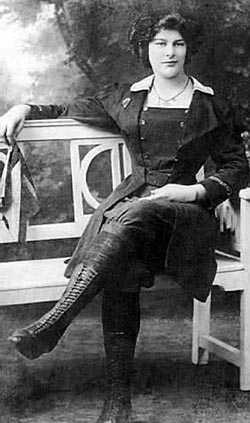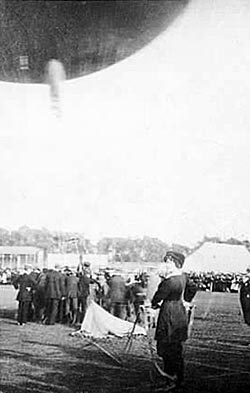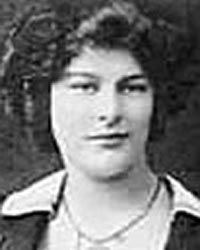
'Dolly' Shepherd (1887-1983)
Though women had been going up in hot-air balloons since 1784, parachuting to earth from 2,000 or more feet was still a spectacular feat in 1904 when Dolly Shepherd (married name Elizabeth Sedgwick) made her first jump at age 17. Despite a number of close calls, she not only survived an eight year career as Britain's "Queen of the Air", but a few years before her death in 1983, (at age 96), she flew with the Red Devils, whose modern parachuting techniques she greatly admired.
Dolly Shepherd
Dolly Shepherd, the famous balloonist is shown taking off in her hot-air balloon, at the Pickering Gala, on Wednesday 26 July 1911.
 Dolly Shepherd, Pickering Gala, Wed. July 26, 1911 Note : this image shows gas balloons in use not hot-air (smoke) as mentioned in the text [Chris Lynch 10/02] Chris has now [also 10/02] contributed an essay on the 'smoke' balloon and balloonists - see "further reading" section at end of page - thanks Chris.
The gala was held in the Avenue Field, next to Pickering Castle. Dolly Shepherd would tour the country transporting her balloon to events with four horses and a wagon. The balloon was inflated with hot-air after building a bonfire close to it. When the balloon rose Dolly hung onto a trapeze below. When it was high enough she would pull a rip cord in order to make the balloon collapse. She would then open a parachute and float back down to the ground. ...more
 Dolly Shepherd in her parachuting costume c.1910 Lomax, Judy, Women of the Air, Dodd, Mead & Co., 1987
 Dolly Shepherd, Wolverhampton, 1910 Shepherd is astride the sling and gripping the trapeze bar, with her parachute in readiness next to the balloon's basket
Further Reading
Smoke Ballooning 101 Smoke ballooning has been around per se since mid 19th cen. It was alive until a few months ago, when its last practitioner, Peter Kreig, passed away Smoke balloons are distinctive for their wide opening at the bottom, unlike the gas balloon with its tied off appendix; also for their chopped teardrop shape. Smoke ballooning starts with a fire pit dug into the ground, connected by a covered trench leading up to the balloon. The fire is built to a high state, and then covered with wet straw or some other covering agent, forcing the smokey heat towards the balloon. The balloon itself is a cheap contraption, a large bag built of cottin muslin, firmly staked to the ground before ascensions. The smoke would, arguably, fill the pores of the balloon; it also had the properties of a heat sink, allowing longer/higher ascensions. The balloon is hoisted up by pulley between two posts, and then the heat is applied. When the balloon is full, we call this superheated, the aeronaut is buckled to the parachute which is already rigged to the balloon. On command, the balloon is released, rising between 1,000 feet up to (2,500) feet, whereupon the aeronaut releases the parachute and floats gently back to earth. There is a weight, usually a sandbag affixed to the top of the balloon, and when the weight of the aeronaut is no longer at the bottom, the balloon inverts and streamers back to earth, hopefully close to the take off spot. By their nature, all smoke ascensions were parachute drops, as without the parachute, the balloon would cool, only to smash the aeronaut back into the earth. Early in the history of Smoke ballooning, entrepeneurs found the draw of a pretty young woman was irresistable to crowds, and would sometimes go so far as to pick women out of the audience. Inductively, it seems the careers of many women in this sport were short., as the young men in the audience would find them in turn irresistable, marrying them away from a life of adventure. This was merciful, as the life expectancy of 19th century smoke balloonists was pointedly shorter than most. Balloons would rip from overheating, or burn from an aberant spark, or the lines and releases would jam, maiming or killing many aeronauts of the period. Unscrupulous promoters also were known for flying balloons well beyond their periods of optimun safety. Nonetheless, the bravery of these early pioneers introduced countless people to the world of flight, especially those living in rural towns or settings, e.g. those who might not be able to afford ascensions by the more complex and costly gas balloons of the period. Moreover, those women who did establish careers in flying, like Dolly Shepherd, Carlotta Myers, Nellie Thurston and others, seemed to establish a level of professionalism and safety equal, and in many cases, far in advance of their male counterparts.
|
© Copyright 1999-2002 CTIE - All Rights Reserved - Caution |
 'Dolly' Shepherd
'Dolly' Shepherd